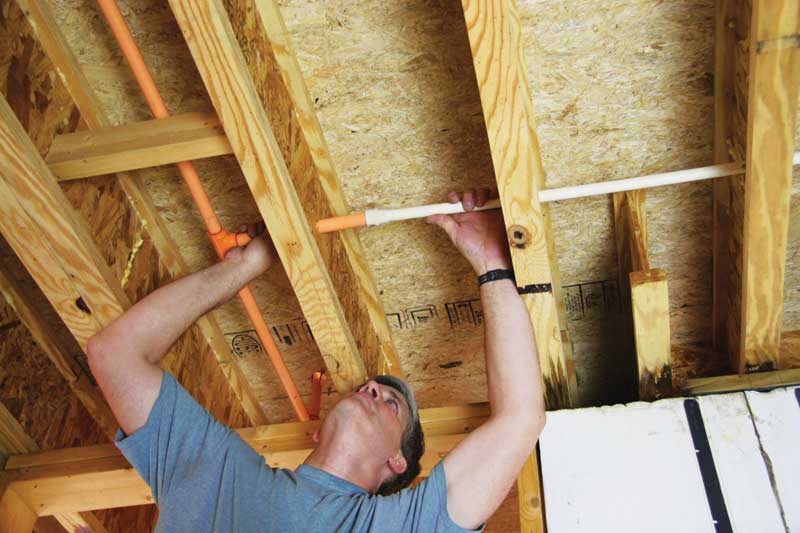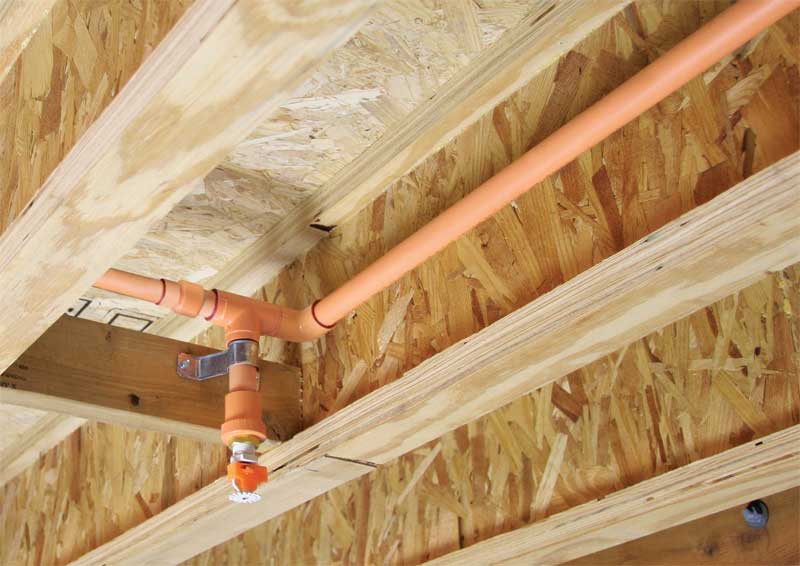Strong materials make the fire protection difference

Fire protection configurations explained
Multi-purpose and dedicated systems differ in key ways. Before working to integrate a fire-protection system within a residential structure, it is worthwhile to develop a thorough understanding of the different configurations.
Multi-purpose systems
Incorporation into a home’s main plumbing is an effective way of achieving fire protection within a multi- or single-family dwelling. One of the advantages of this method is a fire protection system is effectively ‘tested’ each time cold water is switched on within a home. Multi-purpose systems can also be favourable from a design perspective, eliminating the need for two entirely separate system designs. For these systems, it is important to investigate local codes and standards to ensure multi-purpose systems are approved within the local jurisdiction.
Standalone systems
The standalone configuration, most often used with systems, allows for more versatile and adaptable design throughout varied applications—this type of system is often referred to as a ‘main-and-branch’ system. Different branches of CPVC are able to be routed where they are needed, stemming from one main water source. While this method necessitates two separate designs between a home’s plumbing and its fire protection, it also allows for a more straightforward fire-protection system. This contrasts to cross-linked polyethylene (PEX) systems, which while integrated into the plumbing, are looped vertically, sometimes requiring additional piping material.
Certain jurisdictions, however, insist on multi-purpose systems. In these instances, a passive purge system can be used to maintain the benefits of a standalone system while remaining applicable under jurisdictional considerations. This simply combines the use of a standard standalone system with a single connection to a toilet within the home, allowing water to move through the system on a regular basis.
Design and installation considerations
Through the use of a standalone system, combined with the other advantages offered by systems, the total expense of a CPVC fire-protection system is one of the most cost-effective options available in residential fire protection. A study commissioned by the author’s firm, based on California homes classified under the U.S.-based National Fire Protection Association’s (NFPA’s) 13D category for residential homes, for instance, showed in both standalone and multi-purpose configurations, CPVC fire-protection systems had a lower installed cost per square foot than PEX multi-purpose systems.
The joining method of CPVC pipe and fittings is a major part of this. Pipe systems, specifically, are joined through the process of solvent welding. When performed correctly as taught through some CPVC on-the-job training programs and support, the joints in the system become the strongest component. The solvent welding process offers versatility in design and installation, with no prefabrication needed, allowing for simple workability around additional utilities that may be running throughout a residence. As with all materials, CPVC must be properly installed by well-trained professionals. While solvent welding can be performed quickly, it becomes important adequate care is taken during the assembly.

The design of a CPVC system can be performed using many popular building information modelling (BIM) software programs, with pipe and fittings objects available for use. The utilization of BIM programs can help designers easily detect and prevent design conflicts, quickly create multiple designs for comparison to make the best value-engineered solution, create detailed outputs for accurate cost estimates, and lower costs by reducing onsite errors.
Comparatively, PEX is mechanically joined through use of insert fittings. In certain cases, these fittings can cause pressure loss in the system—this must be accounted for when designing with PEX.
PEX has made inroads for fire protection within markets where it has been established as a popular plumbing choice. Commonly, plumbers will simultaneously install both the home’s plumbing system and a fire-protection system. However, it is important to remember the latter is a specialty construction—it is always best practice to contract with certified fire sprinkler contractors for installation of such systems.
Material performance
CPVC has made inroads in several markets in large part due to the performance capabilities inherent to the product itself. For instance, the hydraulic capabilities of CPVC are dependent on the material’s larger internal diameter, which is a result of adhering to iron pipe size and a standard dimension ratio (SDR) of 13.5. This means achieving desired flow densities at a given sprinkler head within a CPVC system is possible with less and smaller pipe, helping to further drive down material costs.
Additionally, the hydraulic capabilities of PEX are inherently inferior to CPVC systems—PEX has a smaller outside diameter and a thicker pipe wall than CPVC. This narrows the inside pipe’s diameter, decreasing the volume of water that can be deployed to stop a fire. This often means in order for PEX to achieve the necessary hydraulic flow density at a given sprinkler head, PEX piping either needs to be upsized, or additional PEX pipe would need to be introduced to the system through a technique called ‘looping.’ Both of these options can potentially drive up the cost of installing the system due to the increased materials necessary.
Extensive testing has shown CPVC has good smoke and flame characteristics, a major consideration when a system is put to its intended use. Pipe and fittings will not propagate flames, nor will the material burn on its own—the pipe’s exterior surface will simply char and cease to burn when flames are removed.
Conclusion
Fire protection is a construction concern that deserves care and consideration, and choosing the right partner to help perform the proper installation across any occupancy is one way in which builders can ensure a safe, reliable, and long-lasting fire protection solution.
 Mark Knurek is a regional market manager for fire protection (Americas) at The Lubrizol Corporation. He has more than 20 years of experience in business development, marketing, engineering, and brand management. With much of his background in the building industry, Knurek is dedicated to developing and maintaining collaborative and productive relationships with key leaders in the fire protection industry. He holds a degree in mechanical engineering and an MBA. Knurek can be reached at mark.knurek@lubrizol.com.
Mark Knurek is a regional market manager for fire protection (Americas) at The Lubrizol Corporation. He has more than 20 years of experience in business development, marketing, engineering, and brand management. With much of his background in the building industry, Knurek is dedicated to developing and maintaining collaborative and productive relationships with key leaders in the fire protection industry. He holds a degree in mechanical engineering and an MBA. Knurek can be reached at mark.knurek@lubrizol.com.
 Peter Mullen has more than 20 years of experience in sales, marketing, and new business development in the plastic piping industry, with the last two decades specializing in chlorinated polyvinyl chloride (CPVC) with Lubrizol Advanced Materials. He is the company’s regional manager for Canada and the northern United States. Mullen’s experience covers plumbing, industrial, and fire-protection applications. He can be reached at peter.mullen@lubrizol.com.
Peter Mullen has more than 20 years of experience in sales, marketing, and new business development in the plastic piping industry, with the last two decades specializing in chlorinated polyvinyl chloride (CPVC) with Lubrizol Advanced Materials. He is the company’s regional manager for Canada and the northern United States. Mullen’s experience covers plumbing, industrial, and fire-protection applications. He can be reached at peter.mullen@lubrizol.com.


